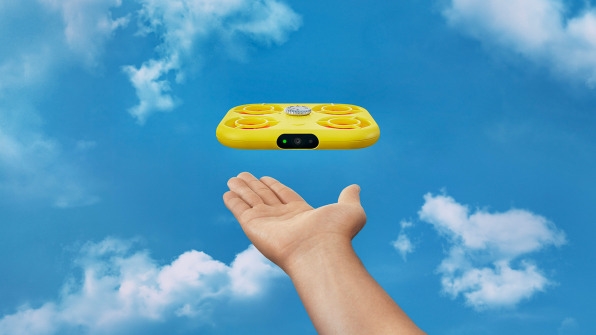Snap’s ‘cute’ Pixy microdrone may be the start of something much bigger
In an early scene in Blade Runner 2049, K. (Ryan Gosling) arrives at a crime scene and his drone automatically lifts up from his flying car and begins hovering around. Because, of course—the drone is his second set of eyes, his “eyes in the sky.”
Extending the sight of human beings seems natural enough, and clearly useful. That combination suggests a technology that, done well, could fold easily into the set of personal technologies we use every day to organize, work, socialize, and entertain ourselves.
That’s why Snap’s new Pixy microdrone is so interesting. Microdrones are nothing new (remember Amazon’s little security drone?). DJI has been making little drones that land in your hand and follow you around for years.
But Snap has created a microdrone that’s simple to control, approachable (i.e. “cute”), and fun. Combine that with the affordable $250 price tag, and Snap may have just opened the door to the mainstreaming of personal drones.

Snap bills Pixy as yet another kind of camera (alongside its Spectacles camera glasses), designed to pour photos and video into the Snapchat app. While announcing the Pixy at the company’s annual developer event Thursday, Snap CEO Evan Spiegel called the Pixy “the perfect new addition to your creative toolbox, helping capture new angles and making every moment fly.”
Snap doesn’t even call Pixy a drone, but rather a “flying camera.” That tag may serve to exempt the device from expectations people may have about drones being complicated, reserved for the tech-savvy. But it also seems to undersell what the Pixy, and personal microdrones like it, might do in the future.
Spiegel seems to hint that Pixy may turn into something more. “I think Pixy opens up a whole new space here because your smartphone can’t fly,” he said. “You can get a totally new and different perspective. And so, in that way, I think Pixy is meaningfully better than what your smartphone can create.”
Indeed, simple-to-use personal microdrones might find strong use cases far outside the realm of social media. Scene: I’ve been traveling for weeks and, arriving back at my home airport late at night, I discover I’ve totally forgotten where in the airport parking lot I’ve left my car (yes, this really happened). My personal drone (fully charged) could fly over the lot and recognize my car (perhaps using a bit of onboard computer vision AI to distinguish my black Prius from somebody else’s black Prius).

It’s also not hard to imagine the Pixy fitting in nicely with a set of personal technologies we may use in a post-smartphone future. Its bird’s-eye view and/or footage could be monitored through the lenses of a pair of mixed-reality glasses. Snap, not coincidentally, has already released two generations of its Spectacles camera glasses and developed a pair of full-fledged AR glasses. I might control the drone using voice commands or even hand gestures picked up by the cameras on the AR glasses. After the drone locates my car, I might suddenly see within the AR glasses a blinking red dot on a map of the parking lot indicating my car. Or, I might see arrows within the glasses guiding me through the lot (or parking garage) in front of me to the location of the car.
The combination of AI and the “eyes in the sky” could have many other use cases, as well. Before I walk into the parking garage late at night, I might send my drone in first to look for any signs of danger.
Who knows if the Pixy will sell better than the Spectacles have. I suspect that they will, based on the price tag and the device’s having a clearer set of immediate use cases.
But rest assured that the product-marketing people at Samsung, Meta, and even Apple will be watching Pixy’s sales numbers carefully, looking for signs that personal microdrones are becoming a thing, ready to get busy on one of their own.
(56)


